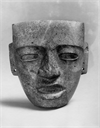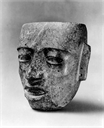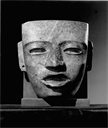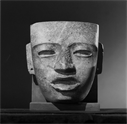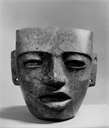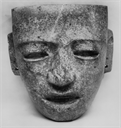Bibliography
Anonymous 1958 A Collection of Pre-Columbian Fine Art. Natural History 67 (3):128-129. p. 128-129.
Benson, Elizabeth P. 1963 Handbook of the Robert Woods Bliss Collection of Pre-Columbian Art. Dumbarton Oaks, Trustees for Harvard University, Washington, D.C., p. 2, cat. 2.
Berrin, Kathleen and Esther Pasztory (EDS.) 1993 Teotihuacan: Art from the City of the Gods. Thames and Hudson: Fine Arts Museums of San Francisco, New York; San Francisco. p. 186, cat. 26.
Bliss, Robert Woods 1947 Indigenous Art of the Americas: Collection of Robert Woods Bliss. National Gallery of Art, Smithsonian Institution, Washington, D.C., p. 25, 53, cat. 121.
Bliss, Robert Woods 1957 Pre-Columbian Art: The Robert Woods Bliss Collection. Text and Critical Analyses by S. K. Lothrop, Joy Mahler and William F. Foshag. Phaidon, New York. p. 239, cat. 36, pl. XXVIII.
Bliss, Robert Woods 1959 Pre-Columbian Art: The Robert Woods Bliss Collection. 2nd ed. Text and Critical Analyses by S. K. Lothrop, Joy Mahler and William F. Foshag. Phaidon, London. p. 247, cat. 36, pl. XXVIII.
Braun, Barbara 1993 Pre-Columbian Art and the Post-Columbian World: Ancient American Sources of Modern Art. Harry N. Abrams, New York. p. 109-110.
Bühl, Gudrun (ED.) 2008 Dumbarton Oaks: The Collections. Published by Dumbarton Oaks Research Library and Collection, Washington, D.C., p. 202-3.
Headrick, Annabeth 2007 The Teotihuacan Trinity: The Sociopolitical Structure of an Ancient Mesoamerican City. University of Texas Press, Austin. p. 55, fig. 3.8, cover.
Moore, Henry, Wilfried Seipel, Palais Harrach (Vienna Austria) and Kunsthistorisches Museum Wien. 1998 Henry Moore, 1898-1986: Eine Retrospektive Zum 100. Geburtstag: Kunsthistorisches Museum Wien, Wien, Palais Harrach, 16. März-9. August 1998. Skira; Kunsthistorisches Museum, Milano, Wien. p. 225, cat. 77, fig. 1.
Pasztory, Esther 1988 A Reinterpretation of Teotihuacan and Its Mural Paintings. In Feathered Serpents and Flowering Trees: Reconstructing the Murals of Teotihuacán, Kathleen Berrin and Clara Millon, eds., pp. 238. Fine Arts Museums of San Francisco, San Francisco. p. 63, fig. 3.15.
Pasztory, Esther 1992 Abstraction and the Rise of a Utopian State at Teotihuacan. In Art, Ideology, and the City of Teotihuacan: A Symposium at Dumbarton Oaks, 8th and 9th October 1988, Janet Catherine Berlo, ed., pp. 281-320. Dumbarton Oaks Research Library and Collection, Washington, D.C., p. 294, fig. 11.
Pasztory, Esther 1997 Teotihuacan: An Experiment in Living. University of Oklahoma Press, Norman. p. 130.
Pasztory, Esther 1998 Pre-Columbian Art. Cambridge University Press, Cambridge, UK; New York. p. 64-65, fig. 44.
Ries, Maurice Ruddell (ED.) 1942 Ancient American Art, 500 B.C.-A.D. 1500; the Catalog of an Exhibit of the Art of the Pre-European Americas, April-June 1942, Santa Barbara Museum of Art. Santa Barbara Museum of Art, Santa Barbara. cat. 201.
Seipel, Wilfried (ED.) 1998 Henry Moore, 1898-1986: Eine Retrospektive Zum 100. Skira; Kunsthistorisches Museum, Milano, Wien. p. 225, cat. 77, fig. 1.
Turner, Margaret H. 1992 Style in Lapidary Technology: Identifying the Teotihuacan Lapidary Industry. In Art, Ideology, and the City of Teotihuacan: A Symposium at Dumbarton Oaks, 8th and 9th October 1988, Janet Catherine Berlo, ed., pp. 89-112. Dumbarton Oaks Research Library and Collection, Washington, D.C., p. 90, fig. 1a.
Exhibition History
"Ancient American Art", Santa Barbara Museum of Art, Santa Barbara, CA, April - June 1942; M. H. De Young Memorial Museum, San Francisco, CA, July - August 1942; Portland Museum of Art, Portland, OR, September - October 1942 (catalogue # 201).
"Indigenous Art of the Americas", National Gallery of Art, Washington DC, April 1947 to July 1962.
"Teotihuacan City of Gods", M. H. de Young Memorial Museum, San Francisco, CA, 5/26 - 10/31/1993. p. 186, cat. no. 26.
"Teotihuacan City of Water, City of Fire", M. H. de Young Memorial Museum, San Francisco, CA, 9/30/2017 - 2/11/2018; Los Angeles County Museum of Art, Los Angeles, CA, 3/25 - 9/3/2018.
Acquisition History
Formerly in the collection of Augusto Vallejo Leal
Purchased from Augusto Vallejo Leal by Joseph Brummer (dealer), February 23, 1934.
Purchased from Joseph Brummer, New York (dealer), by Robert Woods Bliss, March 17, 1937.
Robert Woods Bliss Collection of Pre-Columbian Art, Washington, DC, 1937-1962.
Dumbarton Oaks Research Library and Collection, Pre-Columbian Collection, Washington, DC.
